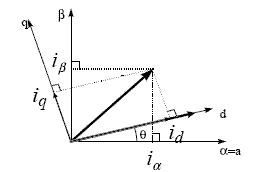 |
LIBML
Version 3.2.4
LIBML DSP Software Library
|
 |
LIBML
Version 3.2.4
LIBML DSP Software Library
|

Functions | |
| static void | tpt_park_f32 (f32_t *pId, f32_t *pIq, f32_t Ialpha, f32_t Ibeta, f32_t aSinVal, f32_t aCosVal) |
| Floating-point Park transform. More... | |
| static void | tpt_park_q31 (q31_t *pId, q31_t *pIq, q31_t Ialpha, q31_t Ibeta, q31_t aSinVal, q31_t aCosVal) |
| Q31 Park transform. More... | |
Forward Park transform converts the input two-coordinate vector to flux and torque components. The Park transform can be used to realize the transformation of the Ialpha and the Ibeta currents from the stationary to the moving reference frame and control the spatial relationship between the stator vector current and rotor flux vector. If we consider the d axis aligned with the rotor flux, the diagram below shows the current vector and the relationship from the two reference frames:

The function operates on a single sample of data and each call to the function returns the processed output. The library provides separate functions for Q31 and floating-point data types.

Ialpha and Ibeta are the stator vector components, pId and pIq are rotor vector components and cosVal and sinVal are the cosine and sine values of theta (rotor flux position).
|
inlinestatic |
Floating-point Park transform.
| [out] | pId | points to output rotor reference frame d. |
| [out] | pIq | points to output rotor reference frame q. |
| [in] | Ialpha | input two-phase vector coordinate alpha |
| [in] | Ibeta | input two-phase vector coordinate beta |
| [in] | aSinVal | sine value of rotation angle theta |
| [in] | aCosVal | cosine value of rotation angle theta |
The function implements the forward Park transform.
|
inlinestatic |
Q31 Park transform.
| [out] | pId | points to output rotor reference frame d. |
| [out] | pIq | points to output rotor reference frame q. |
| [in] | Ialpha | input two-phase vector coordinate alpha |
| [in] | Ibeta | input two-phase vector coordinate beta |
| [in] | aSinVal | sine value of rotation angle theta |
| [in] | aCosVal | cosine value of rotation angle theta |